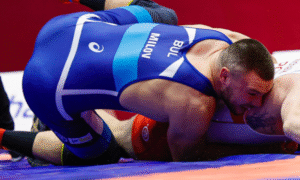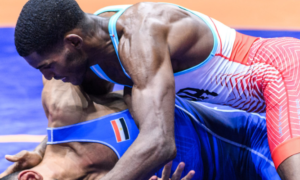Conor Knopick (55 kg, MWC) didn’t do so well at the 2017 US Greco-Roman Cadet World Team Trials. He just didn’t. Two matches, two losses, and that was that. Knopick wasn’t completely invisible prior to Akron last year. He had won or placed at various youth tournaments in and around his native Nebraska, and of course, he already accumulated solid folkstyle skills. But as a “legit” Greco competitor, he was still fresh, still gaining a feel for the style’s indefinable nuances. Knopick wasn’t really supposed to contend for a Cadet World Team spot in ’17, so while his losses might have offered frustration and disappointment, the then-14-year-old regrouped rather quickly.
Actually, he had no choice in the matter.
That’s because Knopick (pronounced kuh-nop-ick — “The k and the n aren’t silent, you just kind of say them together,” he says) and a band of nine other American age-groupers flew off to Serbia the very next week as part of the inaugural Go Greco USA Developmental Program tour. An international training camp sandwiched between two high-level Cadet tournaments (one in Serbia, one in Croatia) represented the featured items on the itinerary.
At the first tournament overseas, the Croatia Open, eventual Cadet World Champion Cohlton Schultz (130 kg, NYAC) took first and Camden Russell (55 kg, MWC) grabbed a silver. Knopick didn’t earn a medal that weekend — but he did learn. He not only gained a fuller grasp of Greco-Roman, but he also found out that the style suited him more appropriately than he had previously recognized. The proceeding training camp only served to confirm these suspicions.
The next weekend in Serbia at the Refik Memišević–Brale Tournament, Knopick advanced to the semis and wound up finishing just short of a bronze medal. This achievement requires context. The Refik Memišević–Brale annually hosts many of the very best Cadet Greco wrestlers on the planet. Knopick’s loss in that semifinal was to Russia’s German Doev, who wound up winning the Worlds later in the summer. No US athlete went unblemished in Serbia. Russell came in fifth and even Schultz dropped his bout in the heavyweight final, falling to Artem Rubantsev (RUS) 6-4. While not intended as a knock on the domestic Cadet tournaments, the fact of the matter is that Knopick, who was unable to advance past the opening round in Akron, performed better against markedly better competition.
Most importantly, his time in Europe offered a carry-over effect. A little over a month after he arrived back home, Knopick surged to the finals of the gigantic Fargo Cadet Nationals. It’s a tournament he now points to as when it all started to “click” in terms of his greater appreciation for Greco-Roman mechanics. The athlete who defeated him in the finals, 2018 Cadet World Team member Hunter Lewis (WI), stands out most notably because of his own intensive international resume.
This past weekend in Akron, as just mentioned, Lewis prevailed again, though he and Knopick didn’t meet. Instead, the Nebraskan faced off with 2017 Cadet World Team member and well-known age-group stud Dylan Ragusin (Ill) in the 55-kilogram semifinal. A high-paced yet tactical battle it was, and one that saw the seasoned Ragusin emerge victorious via criteria. Even still, the message became clear: Knopick is now an elite contender wherever he goes.
Well, guess where he’s going next?
Wednesday morning, Knopick is leaving on a flight to Serbia for the second year in a row. It’s the same prescription that was in place 12 months ago, though the tournament order has flipped. First it’ll be Serbia this coming weekend, and a week hence the 2018 Croatia Open hops into view.
Knopick is (mostly) packed and ready to head on out, but before he does, the 15-year-old prospect took time-out to answer a few questions.
Conor Knopick — 55 kg, MWC
5PM: Why do you think it’s important to gain overseas experience at what is a pretty young age?
Conor Knopick: It helped me understand that, not just for Greco but all of wrestling, how many opportunities we have more than they do overseas and how much we can learn from them, and how well they truly understand wrestling in general. Because, Akron for me last year was not a really good tournament. I didn’t really wrestle well at all. But after going overseas, something clicked when I came back and I started wrestling really well. Greco just kind of hit me like a crazy bombshell.
5PM: What you hear a lot is that the foreign kids, since this is all they do and are without having to deal with folkstyle, is that their positioning is much more natural and intuitive. Is that something that drew you in?
CN: Oh yeah. I don’t think I’ve ever seen a single European not have the best position ever for Greco compared to anyone from the US. It’s just crazy, it’s amazing how well their positioning is, how they can technique into different moves, and the style they use for Greco compared to the US style for Greco.
5PM: When you are at an international camp, how does the general workout environment differ from the US, even breaking it down to how the coaches are and how they communicate?
CN: In the US, we are big into Go hard, technique hard, wrestle a lot of live, but overseas it is mostly relaxed. It is a relaxing workout where you work on technique and position.
5PM: As you just mentioned, you didn’t have a fantastic Akron in 2017, but then a month and a half later you advanced to the finals in Fargo. That jump in improvement, was that something you carried right into the wrestling room when you got back from Serbia? Or did it all just come together in Fargo?
CN: I think it clicked in Fargo because I was mostly excited for freestyle, but I didn’t do well in freestyle, either. So then I went to Greco, and I just went to go wrestle Greco. But all of the sudden, I knew all of this positioning from overseas and it helped me by a longshot.
5PM: You’ve got so much more to experience yet, but becoming a full-time Greco-Roman athlete, is that something you’re considering for later on?
Conor Knopick: Yes, it is. I feel like Greco comes more fluid to me and is a way more natural and relaxed type of style than folkstyle or freestyle. To me, Greco just latches onto something that makes it is so relaxing to wrestle. I am actually enjoying it while I’m wrestling Greco. With freestyle and folkstyle, I feel like those are really pressurizing type of styles. They are so jittery.
I think it opened up my eyes as to how much you can push yourself, how far you can go in wrestling, and how much you can do in the sport. Anyone can go pretty far as long as they put their mind into it.
CLICK HERE TO DONATE TO THE USA GRECO-ROMAN PROGRAM
Listen to “5PM16: Andrew Berreyesa and Brandon Mueller” on Spreaker.
SUBSCRIBE TO THE FIVE POINT MOVE PODCAST
iTunes | Stitcher | Spreaker | Google Play Music | RSS


















